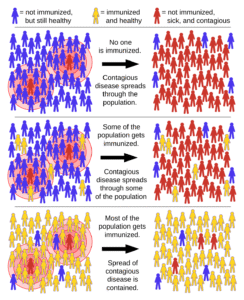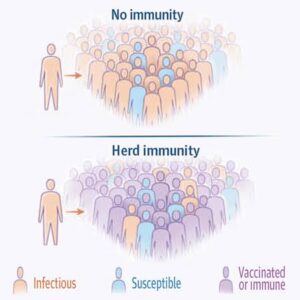Back to: MICROBIOLOGY 100 LEVEL
Welcome to class!
You’re doing so well! It’s always a pleasure to guide you through these important topics that show how science helps protect not just individuals, but whole communities. Today, we’re learning about something you may have heard a lot during health campaigns and the COVID-19 pandemic — herd immunity. It’s a powerful concept that shows how we can protect each other, especially those who cannot protect themselves.
Herd Immunity
Herd immunity, also called community immunity, happens when a large portion of a population becomes immune to a disease, making it difficult for the disease to spread. This protection doesn’t just help those who are immune — it also protects those who are not immune, like newborn babies, the elderly, and people with certain illnesses.

Let’s break it down with a simple Nigerian example.
Imagine a classroom where one student has a contagious cough. If everyone else is vaccinated against the illness causing the cough, that student won’t be able to pass it to anyone — the sickness stops with them. Even if one or two students aren’t vaccinated, they’re still safe because the cough has no one else to spread to. That’s herd immunity.
How Does It Work?
Herd immunity works best when:
A high percentage of people are immune (either through vaccination or past infection).
The disease spreads from person to person (like measles, polio, or influenza).
When enough people are immune:
The chain of transmission is broken.
The disease begins to die out in the community.
Even unvaccinated people are protected, because the disease has nowhere to go.
Vaccination and Herd Immunity
Vaccination is the safest way to achieve herd immunity. If we rely only on natural infection, many people will get very sick or even die before reaching community protection.
For some diseases, at least 80–95% of the population needs to be immune for herd immunity to work.
Example: Measles is so contagious that over 90% of people must be vaccinated to stop its spread.
Diseases Where Herd Immunity Matters
Polio: Still being eradicated in parts of the world, including some African regions.
Measles: Easily prevented through the MMR vaccine.
COVID-19: Vaccination campaigns aimed to reach herd immunity levels worldwide.
Limitations of Herd Immunity
It doesn’t work for all diseases. Some infections, like tetanus, are not spread from person to person, so herd immunity doesn’t apply.

If too many people avoid vaccination, herd immunity breaks down, and outbreaks can happen.
Summary
- Herd immunity occurs when most of a population becomes immune to a disease, protecting even those who are not immune.
- It reduces how easily diseases spread in a community.
- Vaccination is the safest and most effective way to achieve herd immunity.
- It protects vulnerable people who cannot be vaccinated.
- Herd immunity only works when a large percentage of the population is immune.
Evaluation
- What is herd immunity, and why is it important?
- How does vaccination help achieve herd immunity?
- Name one disease where herd immunity does not apply and explain why.
- What could happen in a community if too few people are vaccinated?
You’re learning how science helps protect everyone — not just individuals, but whole communities! You have the power to make a difference by understanding and sharing this knowledge. Keep shining, and remember, Afrilearn is proud to be part of your journey. See you in the next class!
